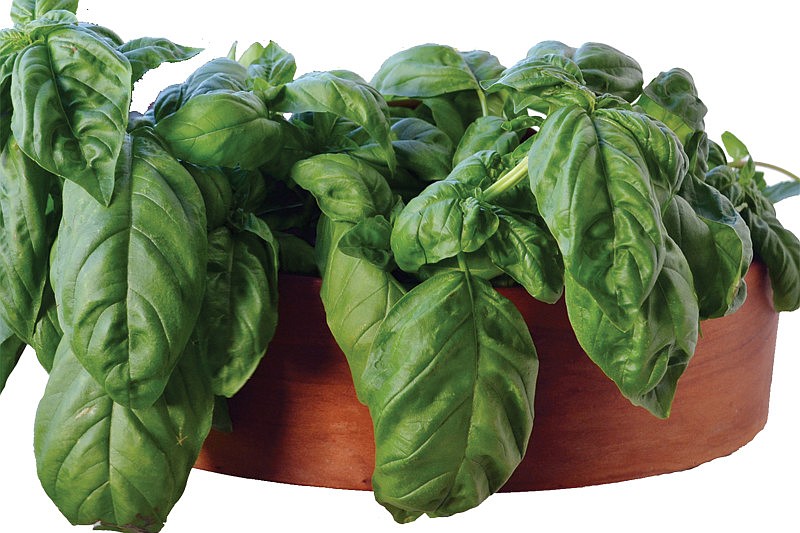- October 19, 2022
-
-
Loading

Loading

If there’s an herb more strongly associated with summer than basil, I don’t know what it is. That is likely because the plant is grown as an annual in the temperate climates of the world. In reality, most basils are perennials, albeit extremely tender ones.
I learned this first-hand when I began to grow herbs on Longboat Key shortly after I moved here. My little garden was inside the pool cage and not far from the edge of a canal in a microclimate that well suited the herb. And, though the plants had become woody, to my great amazement they were still happily producing on Christmas Day. You can be sure that I let my frozen friends up North know about that. (What … me gloat?) Grown in a location it likes and carefully nourished, hydrated and pruned, a basil plant can live for many years.
I first grew this herb in the 1970s in Michigan. If you wanted basil in those days, you had to grow it. This was before plastic-packaged herbs became ubiquitous in the supermarket. It was even before seedlings were readily available via mail or in garden centers.
I started seed on a warming pad and grew the seedlings under lights in the basement. Gardeners have beginners’ luck. I put the seedlings out too small and too early and they not only survived but thrived in a somewhat damp, east-facing spot with light shade in the morning and full sun the rest of the day.
“This is easy,” I thought, leading me to try every kind of basil I could find. Even in those days, there were many and today … wow! The Burpee seed catalog has 21 listings for basil; Stokes has 18; and Johnny’s has 31. If you are inclined to start from seed, you could spend a lifetime experimenting with different varieties in red and purple as well as green, with leaf sizes ranging from a child’s palm (lettuce leaf basil) to a baby’s fingernail (spicy globe and other “microphylla” cultivars).
Most casual gardeners, however, grow from small plants available at the Sarasota Farmers Market and local garden centers. Sweet basil and spicy globe seem to be the most readily obtainable, though you will occasionally find lettuce leaf, opal and other more unusual types. I have bought lovely, organically grown plants from My Mother’s Garden, a vendor at the Saturday market downtown. This year’s seedlings came from good ol’ Home Depot, and they are growing beautifully (though at the moment recovering from the Debby deluge).
It is no longer necessary to grow basil to enjoy it but doing so has some special rewards. A basil plant is a thing of beauty with a finish that would put satin to shame and an enticing scent variously described as pungent, sweet, clove-like, anise-like and having a hint of mint. Six plants will provide more than enough for most households. Plant them (in twos) in a sunny location and start looking up ways to use your harvest. At the top of the list will be pesto, the classic summer topping for your favorite pasta. It is a preparation with many recipes and many debates. Here is a good place to start.
PASTA WITH PESTO
Start to finish: less than 30 minutes
Yield: 4 to 6 entrée servings
INGREDIENTS:
PESTO:
4 cups basil leaves, loosely packed
1/2 cup parsley
2 to 3 cloves garlic, peeled
1/2 cup Parmesan, freshly grated
3/4 cup olive oil
1/4 cup pignoli (pine nuts) (optional)
PASTA:
1 pound linguini
1 tablespoon olive oil
4 tablespoons butter
DIRECTIONS:
• Bring a large kettle of salted water to a rolling boil.
• Prep the pesto ingredients while it is heating: Remove basil leaves from stems and do the same with parsley. Peel the garlic and grate the cheese.
• Add a tablespoon of olive oil to the water. Add the pasta and cook until it is al dente (slightly resistant to the bite). Start to test after 10 minutes. (If you are using fresh pasta, it will cook more quickly.)
• While pasta is cooking, place basil, parsley and garlic in the bowl of a food processor and process to a fine chop. Add the 3/4 cup of olive oil and process to a smooth paste. Add cheese and process briefly to combine. Stir in pine nuts, if using.
• Drain pasta, reserving about 1/4 cup of the cooking water.
• Return pasta to cooking pot; add butter in small bits.
• Add pesto and toss to combine. If it seems too stiff, add reserved cooking water a tablespoon at a time to achieve desired consistency.
• Serve immediately with a green salad and crusty bread.
* Pesto can be made ahead without cheese and refrigerated or frozen in individual portions or even an ice cube tray, if desired.